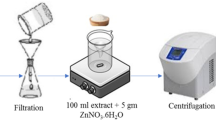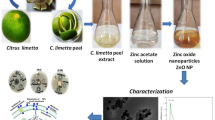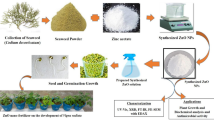Abstract
Pathogenic fungal infections in fruit cause economic losses and have deleterious effects on human health globally. Despite the low pH and high water contents of vegetables and fresh, ripened fruits, they are prone to fungal and bacterial diseases. The ever-increasing resistance of phytopathogens toward pesticides, fungicides and bactericides has resulted in substantial threats to plant growth and production in recent years. However, plant-mediated nanoparticles are useful tools for combating parasitic fungi and bacteria. Herein, we synthesized biogenic manganese oxide nanoparticles (MnONPs) from an extract of Punica granatum (P. granatum), and these nanoparticles showed significant antifungal and antibacterial activities. The production of MnONPs from plant extracts was confirmed by infrared spectroscopy (FTIR), X-ray diffraction (XRD) and UV visible spectroscopy (UV). The surface morphology and shape of the nanoparticles were characterized by scanning electron microscopy (SEM) and transmission electron microscopy (TEM). Using a detached fruit method, the MnONPs were shown to exhibit significant antimicrobial activities against two bacterial strains, E. coli and S. aureus, and against the fungal species P. digitatum. The results revealed that the MnONPs had a minimum antimicrobial activity at 25 µg/mL and a maximum antimicrobial activity at 100 µg/mL against bacterial strains in lemon (citrus). Furthermore, the MnONPs exhibited significant ROS scavenging activity. Finally, inconclusive results from the green-synthesized MnONPs magnified their significant synergetic effects on the shelf life of tomatoes (Lycopercicum esculantum) and indicated that they could be used to counteract the phytopathological effects of postharvest fungal diseases in fruits and vegetables. Overall, this method of MnONPs synthesis is inexpensive, rapid and ecofriendly. MnONPs can be used as potential antimicrobial agents against different microbial species.
Graphical Abstract













Similar content being viewed by others
Data availability and material
Healthy equal size Fruit samples were purchased from fruit market. Nanoparticles were prepared in lab and their characterizations were performed in Shanghai Jiao tong University Analysis center with proper procedure. All nanomaterial procedure and applications data will be provided on reasonable request to Corresponding Author.
References
Abbasi, B. A., et al. (2020). Bioactivities of Geranium wallichianum leaf extracts conjugated with zinc oxide nanoparticles. Biomolecules, 10, 38.
Ahmad, M. M., Kotb, H. M., Mushtaq, S., Waheed-Ur-Rehman, M., Maghanga, C. M., & Alam, M. W. (2022). Green Synthesis of Mn+ Cu Bimetallic Nanoparticles Using Vinca rosea Extract and Their Antioxidant, Antibacterial, and Catalytic Activities. Crystals, 12, 72.
Ahmad, W., Jaiswal, K. K., & Soni, S. (2020). Green synthesis of titanium dioxide (TiO2) nanoparticles by using Mentha arvensis leaves extract and its antimicrobial properties. Inorganic and Nano-Metal Chemistry, 50, 1032–1038.
Al-Dhabaan, F. (2018). First record of Rhizopus oryzae from stored apple fruits in Saudi Arabia. Plant Pathology and Quarantine, 8, 116–121.
Al-Zubaidi, S., Al-Ayafi, A., & Abdelkader, H. (2019). Biosynthesis, Characterization and Antifungal Activity of Silver Nanoparticles by Aspergillus Niger Isolate. Journal of Nanotechnology Research, 2, 022–035.
Bakhy, E. A., Zidan, N. S., & Aboul-Anean, H. E. D. (2018). The effect of nano materials on edible coating and films’ improvement. The International Journal of Pharmaceutical Research and Allied Sciences, 7, 20–41.
Boomi, P., Ganesan, R., Poorani, G., Prabu, H. G., Ravikumar, S., & Jeyakanthan, J. (2019). Biological synergy of greener gold nanoparticles by using Coleus aromaticus leaf extract. Materials Science and Engineering: C, 99, 202–210.
Chandirika, J. U., Selvi, S. T., & Annadurai, G. (2018). Synthesis and characterization of silver nanoparticle using Melia azedarach for vegetable coating and antibacterial activity. Journal of Innovations in Pharmaceutical and Biological Sciences, 5, 38–42.
Chartarrayawadee, W., et al. (2020). Green synthesis and stabilization of silver nanoparticles using Lysimachia foenum-graecum Hance extract and their antibacterial activity. Green Processing and Synthesis, 9, 107–118.
Cherian, E., Rajan, A., & Baskar, G. (2016). Synthesis of manganese dioxide nanoparticles using co-precipitation method and its antimicrobial activity. International Journal of Modern Science and Technology, 1, 17–22.
Chitra, K., & Annadurai, G. (2014). Antibacterial activity of pH-dependent biosynthesized silver nanoparticles against clinical pathogen. BioMed research international.
Ciorîță, A., et al. (2020). Green Synthesis of Ag-MnO2 Nanoparticles using Chelidonium majus and Vinca minor extracts and their in vitro cytotoxicity. Molecules, 25, 819.
Das, D., Nath, B. C., Phukon, P., & Dolui, S. K. (2013). Synthesis of ZnO nanoparticles and evaluation of antioxidant and cytotoxic activity. Colloids and Surfaces b: Biointerfaces, 111, 556–560.
Devanesan, S., et al. (2018). Antimicrobial and cytotoxicity effects of synthesized silver nanoparticles from Punica granatum peel extract. Nanoscale Research Letters, 13, 315.
Dobrucka, R. (2018). Antioxidant and catalytic activity of biosynthesized CuO nanoparticles using extract of Galeopsidis herba. Journal of Inorganic and Organometallic Polymers and Materials, 28, 812–819.
El-Naggar, N. E., Hussein, M. H., & El-Sawah, A. (2017). A. Bio-fabrication of silver nanoparticles by phycocyanin, characterization, in vitro anticancer activity against breast cancer cell line and in vivo cytotxicity. Scientific Reports, 7, 1–20.
Fernandes, R. A., et al. (2018). Antimicrobial potential and cytotoxicity of silver nanoparticles phytosynthesized by pomegranate peel extract. Antibiotics, 7, 51.
Gharehyakheh, S., et al. (2020). Effect of gold nanoparticles synthesized using the aqueous extract of Satureja hortensis leaf on enhancing the shelf life and removing Escherichia coli O157: H7 and Listeria monocytogenes in minced camel’s meat: The role of nanotechnology in the food industry. Applied Organometallic Chemistry, 34, e5492.
Ghidan, A. Y., Al-Antary, T. M., & Awwad, A. M. (2016). Green synthesis of copper oxide nanoparticles using Punica granatum peels extract: Effect on green peach Aphid. Environmental Nanotechnology, Monitoring & Management, 6, 95–98.
Gulbagca, F., Ozdemir, S., Gulcan, M., & Sen, F. (2019). Synthesis and characterization of Rosa canina-mediated biogenic silver nanoparticles for anti-oxidant, antibacterial, antifungal, and DNA cleavage activities. Heliyon, 5, e02980.
Haneefa, M., Jayandran, M., & Balasubramanian, M. (2017). Evaluation of antimicrobial activity of green-synthesized manganese oxide nanoparticles and comparative studies with curcuminaniline functionalized nanoform. Asian Journal of Pharmaceutical and Clinical Research, 10, 347–352.
Hassanien, R., Husein, D. Z., & Al-Hakkani, M. F. (2018). Biosynthesis of copper nanoparticles using aqueous Tilia extract: Antimicrobial and anticancer activities. Heliyon, 4, e01077.
Hoseinpour, V., & Ghaemi, N. (2018). Green synthesis of manganese nanoparticles: Applications and future perspective–A review. Journal of Photochemistry and Photobiology b: Biology, 189, 234–243.
Hoseinpour, V., Souri, M., & Ghaemi, N. (2018). Green synthesis, characterisation, and photocatalytic activity of manganese dioxide nanoparticles. Micro & Nano Letters, 13, 1560–1563.
Ifeanyichukwu, U. L., Fayemi, O. E., & Ateba, C. N. (2020). Green synthesis of zinc oxide nanoparticles from pomegranate (Punica granatum) extracts and characterization of their antibacterial activity. Molecules, 25, 4521.
Iqbal, J., Abbasi, B. A., Mahmood, T., Hameed, S., Munir, A., & Kanwal, S. (2019). Green synthesis and characterizations of Nickel oxide nanoparticles using leaf extract of Rhamnus virgata and their potential biological applications. Applied Organometallic Chemistry, 33, e4950.
Iqbal, J., et al. (2021). Green synthesis of zinc oxide nanoparticles using Elaeagnus angustifolia L. leaf extracts and their multiple in vitro biological applications. Scientific Reports, 11, 1–13.
Jadhav, M. S., Kulkarni, S., Raikar, P., Barretto, D. A., Vootla, S. K., & Raikar, U. (2018). Green biosynthesis of CuO & Ag–CuO nanoparticles from Malus domestica leaf extract and evaluation of antibacterial, antioxidant and DNA cleavage activities. New Journal of Chemistry, 42, 204–213.
Jafarzadeh, S., Nafchi, A. M., Salehabadi, A., Oladzad-Abbasabadi, N., & Jafari, S. M. (2021). Application of bio-nanocomposite films and edible coatings for extending the shelf life of fresh fruits and vegetables. Advances in Colloid and Interface Science, 291, 102405.
Jayandran, M., Haneefa, M. M., & Balasubramanian, V. (2015). Green synthesis and characterization of Manganese nanoparticles using natural plant extracts and its evaluation of antimicrobial activity. Journal of Applied Pharmaceutical Science, 5, 105–110.
Joshi, S. J., Geetha, S., Al-Mamari, S., & Al-Azkawi, A. (2018). Green synthesis of silver nanoparticles using pomegranate peel extracts and its application in photocatalytic degradation of methylene blue. Jundishapur Journal of Natural Pharmaceutical Products, 13.
Khan, M., et al. (2018). Plant extracts as green reductants for the synthesis of silver nanoparticles: Lessons from chemical synthesis. Dalton Transactions, 47, 11988–12010.
Khan, S. A., & Lee, C. -S. (2020). Green biological synthesis of nanoparticles and their biomedical applications. In: Applications of nanotechnology for green synthesis. Springer, pp. 247–280.
Khatami, M., Nejad, M. S., Salari, S., & Almani, P. G. N. (2016). Plant-mediated green synthesis of silver nanoparticles using Trifolium resupinatum seed exudate and their antifungal efficacy on Neofusicoccum parvum and Rhizoctonia solani. IET Nanobiotechnology, 10, 237–243.
Kowsalya, E., MosaChristas, K., Balashanmugam, P., & Rani, J. C. (2019). Biocompatible silver nanoparticles/poly (vinyl alcohol) electrospun nanofibers for potential antimicrobial food packaging applications. Food Packaging and Shelf Life, 21, 100379.
Kumar, M., Dandapat, S., Ranjan, R., Kumar, A., & Sinha, M. (2018). Plant mediated synthesis of silver nanoparticles using Punica granatum aqueous leaf extract. Journal of Microbiology and Experimentation, 6, 175–178.
Kumar, V., Singh, K., Panwar, S., & Mehta, S. K. (2017). Green synthesis of manganese oxide nanoparticles for the electrochemical sensing of p-nitrophenol. International Nano Letters, 7, 123–131.
Kunkalekar, R., Naik, M., Dubey, S., & Salker, A. (2013). Antibacterial activity of silver-doped manganese dioxide nanoparticles on multidrug-resistant bacteria. Journal of Chemical Technology & Biotechnology, 88, 873–877.
Kwon, J. -H., Ryu, J. -S., Chi, T. T. P., Shen, S. -S., & Choi, O. (2012). Soft rot of Rhizopus oryzae as a postharvest pathogen of banana fruit in Korea. Mycobiology, 40, 214–216.
Lu, H., Zhang, X., Khan, S. A., Li, W., & Wan, L. (2021). Biogenic Synthesis of MnO2 Nanoparticles With Leaf Extract of Viola betonicifolia for Enhanced Antioxidant, Antimicrobial, Cytotoxic, and Biocompatible Applications. Frontiers in Microbiology, 3329.
Lustriane, C., Dwivany, F. M., Suendo, V., & Reza, M. (2018). Effect of chitosan and chitosan-nanoparticles on post harvest quality of banana fruits. Journal of Plant Biotechnology, 45, 36–44.
Madbouly, A. K. (2021). The Efficacy of Green Synthesized Nanosilver in Reducing the Incidence of Post-Harvest Apple Fruit Brown Rot. Journal of Fungi, 7, 473.
Mahdavi, B., Paydarfard, S., Zangeneh, M. M., Goorani, S., Seydi, N., & Zangeneh, A. (2020). Assessment of antioxidant, cytotoxicity, antibacterial, antifungal, and cutaneous wound healing activities of green synthesized manganese nanoparticles using Ziziphora clinopodioides Lam leaves under in vitro and in vivo condition. Applied Organometallic Chemistry, 34, e5248.
Mahlangeni, N. T., & Moodley, R. (2021). Biosynthesis of manganese oxide nanoparticles using Urginea sanguinea and their effects on cytotoxicity and antioxidant activity. Advances in Natural Sciences: Nanoscience and Nanotechnology, 12, 015015.
Manjula, R., Thenmozhi, M., Thilagavathi, S., Srinivasan, R., & Kathirvel, A. (2020). Green synthesis and characterization of manganese oxide nanoparticles from Gardenia resinifera leaves. Materials Today: Proceedings, 26, 3559–3563.
Munir, A., et al. (2019). Ultrasmall co@ co (OH) 2 nanoclusters embedded in N-enriched mesoporous carbon networks as efficient electrocatalysts for water oxidation. Chemsuschem, 12, 5117–5125.
Muthuvel, A., Jothibas, M., & Manoharan, C. (2020). Synthesis of copper oxide nanoparticles by chemical and biogenic methods: Photocatalytic degradation and in vitro antioxidant activity. Nanotechnology for Environmental Engineering, 5, 1–19.
Nair Sreekala, G., Abdullakutty, F., & Beena, B. (2019). Green synthesis, characterization, and photo catalytic degradation efficiency of Trimanganese Tetroxide nanoparticle. International Journal of Nano Dimension, 10, 400–409.
Nasiriboroumand, M., Montazer, M., & Barani, H. (2018). Preparation and characterization of biocompatible silver nanoparticles using pomegranate peel extract. Journal of Photochemistry and Photobiology b: Biology, 179, 98–104.
Negahdary, M., Arefian, Z., Dastjerdi, H. A., & Ajdary, M. (2015). Toxic effects of Mn2O3 nanoparticles on rat testis and sex hormone. Journal of Natural Science, Biology, and Medicine, 6, 335.
Nikkhah, M., Hashemi, M., Najafi, M. B. H., & Farhoosh, R. (2017). Synergistic effects of some essential oils against fungal spoilage on pear fruit. International Journal of Food Microbiology, 257, 285–294.
Ogunyemi, S. O., et al. (2019). Biosynthesis and characterization of magnesium oxide and manganese dioxide nanoparticles using Matricaria chamomilla L. extract and its inhibitory effect on Acidovorax oryzae strain RS-2. Artificial Cells, Nanomedicine, and Biotechnology, 47, 2230–2239.
Perez, M. F., et al. (2016). Native killer yeasts as biocontrol agents of postharvest fungal diseases in lemons. PloS One, 11.
Pugazhendhi, A., Kumar, S. S., Manikandan, M., & Saravanan, M. (2018). Photocatalytic properties and antimicrobial efficacy of Fe doped CuO nanoparticles against the pathogenic bacteria and fungi. Microbial Pathogenesis, 122, 84–89.
Rehana, D., Mahendiran, D., Kumar, R. S., & Rahiman, A. K. (2017). Evaluation of antioxidant and anticancer activity of copper oxide nanoparticles synthesized using medicinally important plant extracts. Biomedicine & Pharmacotherapy, 89, 1067–1077.
Sarkar, S., & Kotteeswaran, V. (2018). Green synthesis of silver nanoparticles from aqueous leaf extract of pomegranate (Punica granatum) and their anticancer activity on human cervical cancer cells. Advances in Natural Sciences: Nanoscience and Nanotechnology, 9, 025014.
Sawicka, B. (2019). “Post-harvest Losses of Agricultural Produce,” in Zero Hunger, Encyclopedia of the UN Sustainable Development Goals, eds W. Leal Filho, A. Azul, L. Brandli, P. Özuyar, and T. Wall (Cham: Springer). 10, 40–1.
Selvaraj, V., Sagadevan, S., Muthukrishnan, L., Johan, M. R., & Podder, J. (2019). Eco-friendly approach in synthesis of silver nanoparticles and evaluation of optical, surface morphological and antimicrobial properties. Journal of Nanostructure in Chemistry, 1–10.
Shah, I. H., Ashraf, M., Niu, Q. L., & Zhang, Y. D. (2022). Controllable synthesis and stabilization of Tamarix aphylla-mediated copper oxide nanoparticles for the management of Fusarium wilt on musk melon. 3 Biotech, 12, 128.
Shah, I. H., et al. (2022). Green synthesis and Characterization of Copper oxide nanoparticles using Calotropis procera leaf extract and their different biological potentials. Journal of Molecular Structure, 132696.
Sharma, D., Kanchi, S., & Bisetty, K. (2019). Biogenic synthesis of nanoparticles: A review. Arabian Journal of Chemistry, 12, 3576–3600.
Shimshoni, J. A., Bommuraj, V., Chen, Y., Sperling, R., Barel, S., Feygenberg, O., et al. (2020). Postharvest fungicide for avocado fruits: Antifungal efficacy and peel to pulp distribution kinetics. Foods, 9, 124.
Shiri, L., Rahmati, S., Ramezani Nejad, Z., & Kazemi, M. (2017). Synthesis and characterization of bromine source immobilized on diethylenetriamine-functionalized magnetic nanoparticles: A novel, versatile and highly efficient reusable catalyst for organic synthesis. Applied Organometallic Chemistry, 31, e3687.
Sivanesan, K., Jayakrishnan, P., Abdul Razack, S., Sellaperumal, P., Ramakrishnan, G., & Sahadevan, R. (2017). Biofabrication of manganese nanoparticle using Aegle marmelos fruit extract and assessment of its biological activities. Nanomedicine Research Journal, 2, 171–178.
Souri, M., Hoseinpour, V., Ghaemi, N., & Shakeri, A. (2019). Procedure optimization for green synthesis of manganese dioxide nanoparticles by Yucca gloriosa leaf extract. International Nano Letters, 9, 73–81.
Souri, M., Hoseinpour, V., Shakeri, A., & Ghaemi, N. (2018). Optimisation of green synthesis of MnO nanoparticles via utilising response surface methodology. IET Nanobiotechnology, 12, 822–827.
Subbaiya, R., et al. (2017). Biomimetic synthesis of silver nanoparticles from Streptomyces atrovirens and their potential anticancer activity against human breast cancer cells. IET Nanobiotechnology, 11, 965–972.
Ullah, F., et al. (2019). Using palynomorphological characteristics for the identification of species of Alsinoideae (Caryophyllaceae): A systematic approach. Grana, 58, 174–184.
Velgosová, O., Mražíková, A., & Marcinčáková, R. (2016). Influence of pH on green synthesis of Ag nanoparticles. Materials Letters, 180, 336–339.
Waithaka, P. N., Gathuru, E. M., Githaiga, B. M., & Kimani, S. N. (2017). Control of passion fruit fungal diseases using essential oils extracted from rosemary (Rosmarinus officinalis) and eucalyptus (Eucalyptus agglomerata) in Egerton University Main Campus Njoro, Kenya. International journal of microbiology.
Wisniewski, M., Droby, S., Norelli, J., Liu, J., & Schena, L. (2016). Alternative management technologies for postharvest disease control: The journey from simplicity to complexity. Postharvest Biology and Technology, 122, 3–10.
Wang, L., Hu, C., & Shao, L. (2017). The antimicrobial activity of nanoparticles: Present situation and prospects for the future. International Journal of Nanomedicine, 12, 1227.
Xue, Y., Zhou, S., Fan, C., Du, Q., & Jin, P. (2019). Enhanced Antifungal Activities of Eugenol-Entrapped Casein Nanoparticles against Anthracnose in Postharvest Fruits. Nanomaterials, 9, 1777.
Zambrano-Zaragoza, M. L., et al. (2018). Nanosystems in edible coatings: A novel strategy for food preservation. International Journal of Molecular Sciences, 19, 705.
Zhang, H., et al. (2017). Efficient removal of Pb (ii) ions using manganese oxides: The role of crystal structure. RSC Advances, 7, 41228–41240.
Zhang, Y., et al. (2022). Multienzymatic Antioxidant Activity of Manganese-Based Nanoparticles for Protection against Oxidative Cell Damage. ACS Biomaterials Science & Engineering.
Acknowledgements
There is no content in this part.
Funding
This work was financial supported by Shanghai Science and Technology Commission (No. 21N21900200; 20392000300), Shanghai Agriculture Applied Technology Development Program (No. 20180203).
Author information
Authors and Affiliations
Contributions
I H S conceptualization Formal analysis, Investigation, Methodology, Visualization, and Writing – original draft. M A M Conceptualization, Soft ware. I A S Formal analysis, Investigation, MA Formal analysis, Visualization, Data correction. S G acquisition of data, analysis and/or interpretation of data. L C Conceptualization, Writing – review & editing. Yidong Zhang: Supervision, Project administration, Writing – review & editing.. All authors read and approved the final manuscript.
Corresponding author
Ethics declarations
Conflict of interest
Authors declare that there is no conflict of interest.
Additional information
Publisher's Note
Springer Nature remains neutral with regard to jurisdictional claims in published maps and institutional affiliations.
Rights and permissions
Springer Nature or its licensor (e.g. a society or other partner) holds exclusive rights to this article under a publishing agreement with the author(s) or other rightsholder(s); author self-archiving of the accepted manuscript version of this article is solely governed by the terms of such publishing agreement and applicable law.
About this article
Cite this article
Shah, I.H., Manzoor, M.A., Sabir, I.A. et al. A green and environmental sustainable approach to synthesis the Mn oxide nanomaterial from Punica granatum leaf extracts and its in vitro biological applications. Environ Monit Assess 194, 921 (2022). https://doi.org/10.1007/s10661-022-10606-7
Received:
Accepted:
Published:
DOI: https://doi.org/10.1007/s10661-022-10606-7




